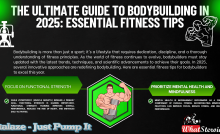Micronutrients For Bodybuilding – Water and Vitamins
Water


Water and vitamins are essential for proper body functioning but is commonly overlooked when considering proper micronutrients intakes. Even mild dehydration, loss of 2-4% body weight, can have a significantly negative impact on athletic performance. Some dehydration during activity is inevitable, gives the fact that during high-intensity activity an individual could sweat out up to two quarts of water per hour, but the gastrointestinal tract can only absorb one quart of water per hour.
Proper hydration
Proper hydration before, during and after the activity is important to have the best possible workouts and thus to gaining the most muscle and losing the most fat.
In terms of daily consumption, the recommended intake is 5 ounces of fluid for every 100 calories consumed. If your diet consists of 4000 calories then you would need to consume 200 fluid ounces each day. To ensure proper hydration levels going into action, one should consume 17-20 fluid ounces two to three hours prior to the activity.
Another 7-10 fluid ounce should consume ten to twenty minutes prior to the activity. During the activity, if possible, it recommends that seven ounces consume every fifteen to twenty minutes. Post-exercise, there are two simple methods that can be utilized to determine the amount of fluid that needs to be consumed. One method is to observe the urine color.
The other method is measuring your body weight before and after activity. Ideally, urine should be very light yellow or clear. If your urine is darker than that, you need to rehydrate until your color returns to appearing light yellow or clear. The recommended rate of fluid consumption during rehydration is 7-10 fluid ounces every ten to twenty minutes until rehydration criteria have been met.
Weight loss as a measure of dehydration
When using weight loss as a measure of dehydration, the difference in body weight is how much fluid was lost during exercise. The amount of fluid lost during activity needs to be replaced by 150%. Meaning, if one pound is lost, that is 16 ounces, 24 fluid ounces need to be consumed at the proper rehydration rate of 7-10 ounces every ten to twenty minutes.
To summarize the recommendation on the water in a very non-technical way: drink fluids regularly, drink during training, and maintain a clear or off-yellow urine color at most times. This will encourage better performance and recovery from training, in addition to keeping organs healthy and properly functioning.
Related Articles: How to Cut 8-10 Pounds of Water While On Steroids
Drink More Water If You Want To Lose Weight And Build Muscle Fast
Vitamins:


There are two classes of vitamins: water-soluble and fat-soluble. This classification based upon how the vitamins absorbed out of the digestive tract and into the body. Water-soluble vitamins are easily absorbed as they are bound to water molecules. Freely move from the digestive tract into the bloodstream.
Fat-soluble vitamins are alongside dietary fat. Meaning, dietary fat must be present in the small intestine at the same time as the fat-soluble vitamin in order for the fat-soluble vitamin to be absorbed. Diets that are chronically too low in fat may result in a fat-soluble vitamin deficiency due to lack of absorption, rather than lack of consumption.
Must Read: The Role of Vitamins in Building Muscle
Once vitamins enter the bloodstream it will need to convert to its active form. Once activated, it most often acts as a regulator for numerous body processes. This means that the active vitamin will either facilitate or inhibit a response within the body.
Vitamins are able to do this in a number of ways. Some vitamins act as intermediate steps in a long series of chemical reactions. Others are coenzymes that must bind to an existing enzyme to activate it and allow a reaction to occur. The functions of vitamins are vast and can vary from assisting with vision, to energy metabolism to bone formation.
To allow these reactions to occur you must take in adequate amounts of each vitamin. The water-soluble vitamins C and B complex are in most fruits, vegetable, and some grains. The exception being vitamin B12, which is in animal-based food products such as seafood, meat, dairy, and eggs.
Type of Vitamins
The fat-soluble vitamins, vitamins A, D, E, and K, are in fat-based food products like vegetable oils, salad dressing, creams, and dairy. The body also produces Vitamins D and K. As the sun’s UV rays interact with the cholesterol in the skin, the body produce vitamin D. The beneficial bacteria of the colon are able to produce vitamin K.
Click Here to Check Price of Multivitamins
Vitamin deficiencies are rare when consuming a balanced diet, although they still can occur. To decrease the likelihood of developing a vitamin deficiency, you need to consume a diet that contains 6-8 servings of fruits and vegetable per day. As well as adequate amounts of grains, proteins, dairy and healthy fats.
Conclusion
Be sure to vary your selection of food you consume as the vitamin level varies which each fruit, vegetable, and grain. This means choosing a variety of greens, carbs, and meats, not just “broccoli, brown rice, and chicken” every day. Dietary fat needs to facilitate the delivery and absorption of fat-soluble vitamins.
Many of the fortified cereals contain adequate amounts of both fat and water-soluble vitamins. If there is concern regarding vitamin intake when on a restrictive diet. A once-a-day you can consume multivitamin to function as a partial insurance policy (though not sustainable indefinitely).
Must Read our Article: Top 20 Weight Loss Bodybuilding Supplements to Try This Summer
Recent Posts
Creatine vs Myostatin: An Expert’s Analysis
Myostatin, a protein encoded by the MSTN gene, acts as a regulator of muscle growth.…
Raloxifene (Evista) 101: A Non-Surgical Solution for Gyno
Raloxifene, a selective estrogen receptor modulator (SERM), is one of the most valuable yet less…
Mastering Bodybuilding in 2025: Top Fitness Tips for Success
Bodybuilding is more than just a sport; it's a lifestyle that requires dedication, discipline, and…
Why Post-Cycle Therapy (PCT) Fails After a Nandrolone Cycle
Nandrolone, or Deca Durabolin, is an injectable anabolic steroid often used by bodybuilders during the…
Counteracting Anabolic Resistance with Adaptogens in Aging Men
As people age, maintaining muscle mass and strength becomes increasingly challenging due to a natural…
Tips on How to Store Peptides and HGH
When peptides are mixed with bacteriostatic water (BAC water), their longevity is highly influenced by…


